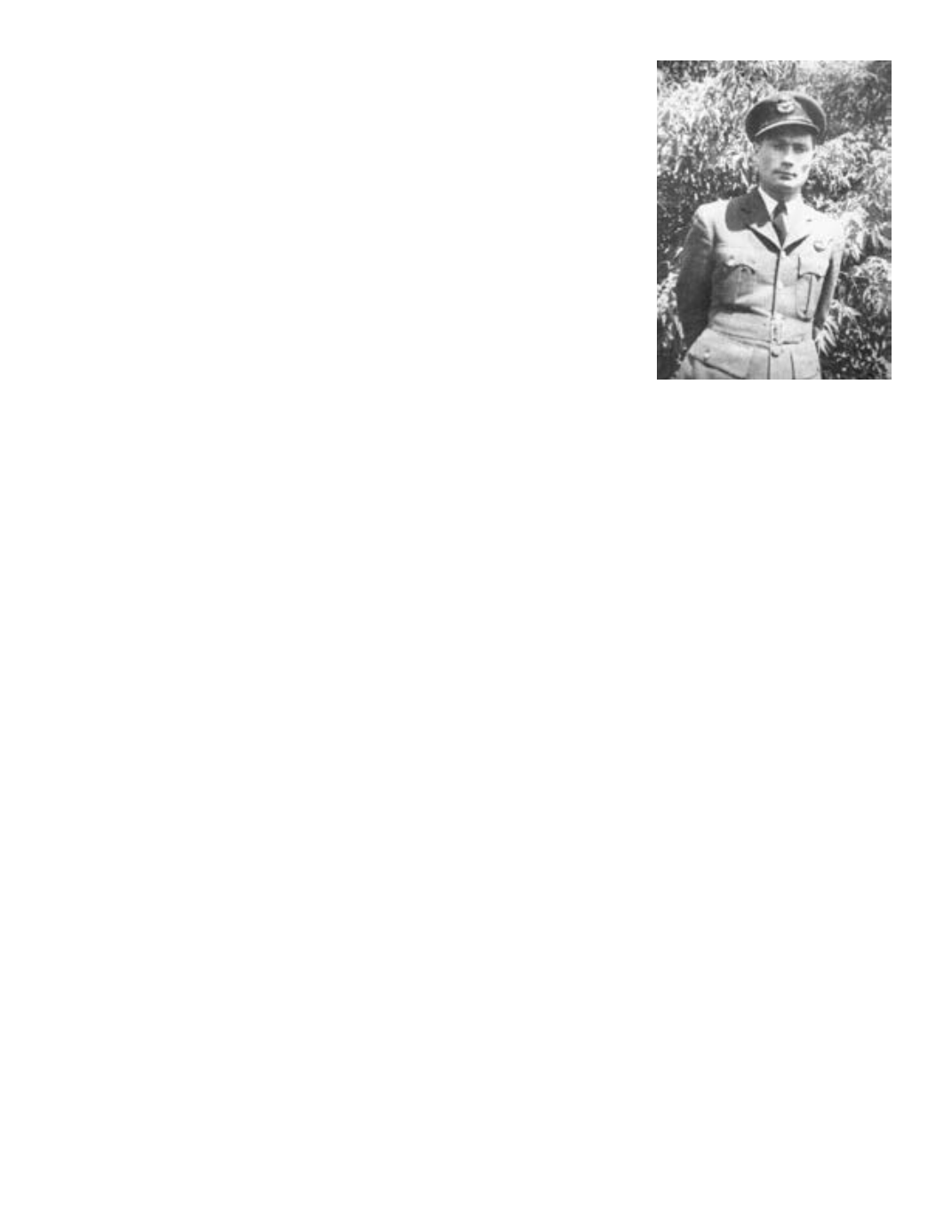
WorldWar II
FallenSoldiers - RockwoodCenotaph
Page 30
GORDONEARLMACK
B115290Trooper
Born:
28April 1925 inEramosaTownship, Ontario
PreviousOccupations:
Farmering, BarnConstruction andCarpenter
Enlisted:
14August 1943 inOrillia, Ontario
Died:
21February 1945 at the age of 19
Buried:
GroesbeekCanadianWar Cemetery, near Nijmegen, Nether-
lands
GordonEarl Mackwas born on 28April 1925 toGeorgeErnest and JennieMay (nee Lillie)Mack of
Lot 16, east half of Con.VI, EramosaTownship. Hewas the third of their four sons (LloydGeorge
b.1919, DonaldThomas b.1921, and JamesA. b.1928). After graduating fromGrade 8 from
EramosaS.S. #7, hewent toworkwith his father and brothers on the farm andbuilding barns in
thearea. He alsoworked as a carpenter forWilliamMcCutcheon in various locations throughout
Erin andEramosaTownships. His hobbieswere fishing, hunting, trapping and readingZaneGrey
westernnovels. When hewas 17, he joined themilitia of the 29thBattery of the 11thFieldRegiment
(Artillery), headquartered inGuelph. He attended a training camp fromMay toNovember 1942.
On 14August 1943 inOrillia, he enlisted in the same regiment andwent through basic training
and additional training inWindsor, NovaScotia. On 26 June 1944, Gordon embarked for England
fromHalifax, arriving seven days later. At this time, hewas in a tank regiment but on 31August,
he transferred into theCanadianBaseReinforcement Battalion of theCanadian InfantryCorps,
in response to the urgent need for infantry to replace heavy losseswhile fighting along the coast
of France and intoBelgium. Upon arrival inBelgium on 17October, hewas assigned to the
Royal Hamilton Light InfantryRegiment (RHLI),Anti-TankSupport Unit. Thiswas shortly after the
beginningof theBattle of theScheldt (where theRhineRiver enters theNorthSea). At this time,
theRHLI was involved in fighting on the islands north of theBelgian port city ofAntwerp, and for
thenext monthswas involved in the liberation of theNetherlands. His letters homementioned the
grim conditions at the front. On 25 January 1945, hewrote to his parents about his hope to live in
southernWales and join theRoyal Navywhen thewar ended.
In the final days of OperationVeritable (8 to 21February 1945), theRHLI was involved in
exceptionally heavy fightingalong theKalkar (Calcar) GochRoad. Trooper GordonEarl Mackwas
killed inaction on 21February 1945 near the town of Keppelen, Germany. In a letter to his parents,
hisCaptain spoke highly of TrooperMack and described how his four-man squadwas advancing
along the side of a roadwhen theywere hit by an artillery shell. Only one seriously injuredman
survived.
Trooper GordonEarl Mackwas initially buried a fewmiles northwest in a cemetery in the small
village of Louisendorf. Shortly after the end of theWar inEurope, his bodywas exhumed and
reburied in theGroesbeekCanadianWar Cemetery, near Nijmegen, Netherlands. His name is
alsomemorialized in theBooks of Remembrance in thePeaceTower of theCanadianParliament
Buildings, Ottawa.
FallenSoldiers - RockwoodCenotaph
1
WILLIAMHENRYP R INSON
J24930FlyingOfficerWO/AG
8March 1 in r
s , Ontario
:
Mining - DiamondDrill Operator
29 pril 1942 inHamilton, t rio
8May 1944 at the ge of 29
osseli sCommunal Cemet ry, near Charleroi, B lgium
WilliamHenryParkinsonwas born on 8March 1915 toWilliamH.
andEliza Jane (neeCoker) Parkinson in the village of Eramosa. His
father died just eight days after his birth. Hewas the youngest of their
three sons (ArchibaldW. b.1908andGeorgeR. b.1910). Hismother
subsequently re-marriedWilliamHodgkinson. After graduating fromGuelphCollegiate at the age of
17, heworked in an interesting variety of farming, includingworking on a ranch anda fur farm. Early
in 1942,Williammoved to the goldmining townof Timmins, Ontario, towork in theConiaurumMine
as adiamond drill operator for a short time before enlisting at Hamilton on 29April 1942.
WilliamHenryParkinson joined theRCAF at Hamilton and after completing his basic training, he
was sent to the #4Wireless (radio) School inGuelph on 21 July 1942 and receivedhis aircraft
WirelessOperator badge -WO. On 21February 1943, Henrywas sent to #2Bombing andGunnery
School inMossbank, Saskatchewanwhere he then received hisAir Gunner badge –AG. One
month later, on21March 1943, hewas commissioned as aPilot Officer (P/O) in theRCAFSpecial
Reserve. After twoweeks leave, hewas sent to #32Operational TrainingUnit (OTU), PatriciaBay
Airbase (nowVictoriaAirport) inBritishColumbiauntil he embarked on a six day trip toEngland on
16 July 1943. On 21September 1943, P/OParkinson,WO/AGwas transferred to the 24OTU and
promoted to the rank of FlyingOfficer (F/O).
On 10 January 1944F/OParkinson,WO/AGwas transferred toBomber Command’sNo. 6Group
(RCAF), No. 61Base for further operational training inYorkshire, England. On 21February, he
was transferred toRCAF 432 (Leaside) Squadron, flyingHalifax III bombers. The evening of 8May
1944, his squadron took part in a raid on the rail yards near Haine-Saint-Pierre inGermanOccupied
Belgium. Near theFrench townof Maubeuge, their Halifaxwas hit by a night fighter and their pilot
(P/O Ibbotson, RAF) ordered all crew tobail-out before attempting an emergency landing. Four
crewmemberswere able to bail-out before the aircraft crashed andburned upon impact with the
loss of the remaining three crewmembers, includingP/O Ibbotson.
German records indicated that F/OWilliamHenryParkinson and his two fellow aircrew (P/OHarry
IbbotsonandF/OStanleyAllenHawkins) were initially buried inwhat was known as a “Comrade’s
Grave” (or sharedgrave) in the small Belgian town of GrandReng. Shortly after the endof theWar
inEurope, their bodieswereexhumed but their individual remainswere not able to be identified.
Their shared remainswere reburiedandmarkedwith all three names in theGosseliesCommunal
Cemetery, near Charleroi, Belgium. His name is alsomemorialized in theBooks of Remembrance in
thePeaceTower of theCanadianParliament Buildings, Ottawa.


